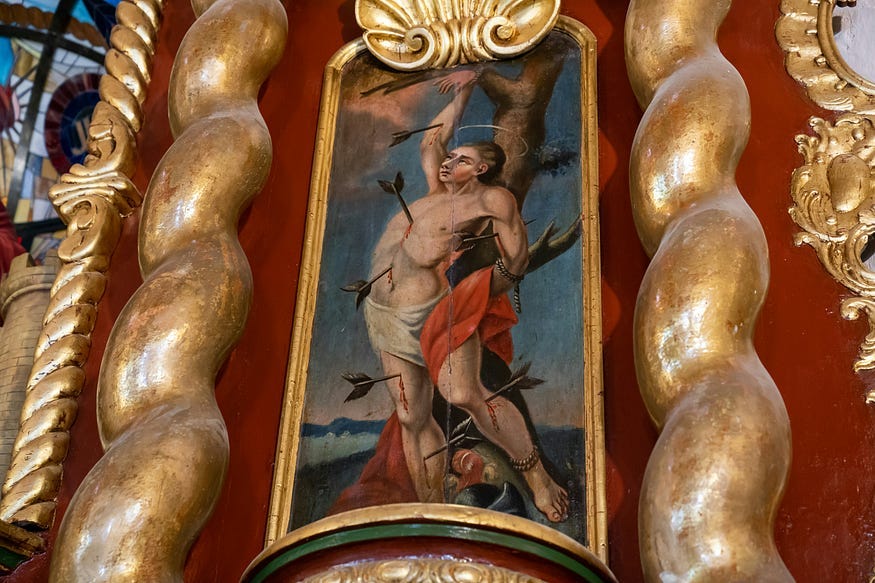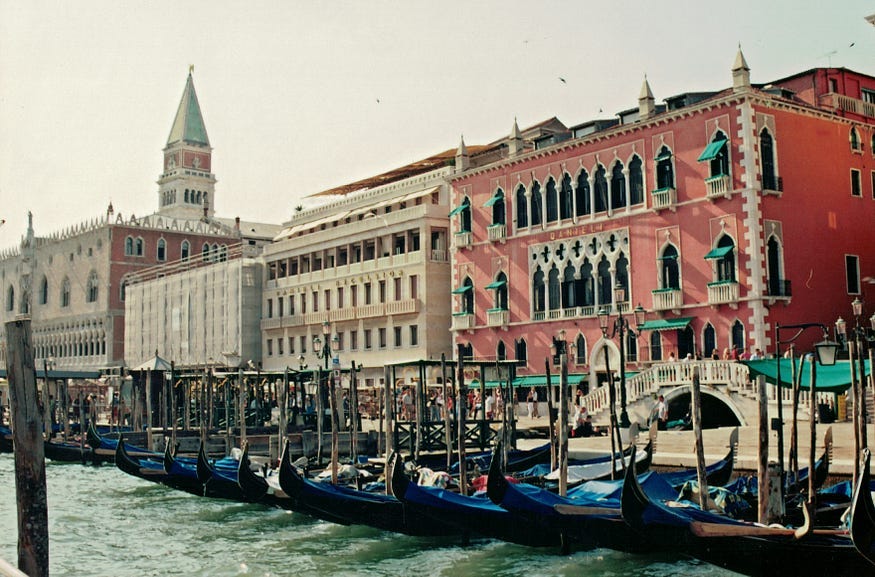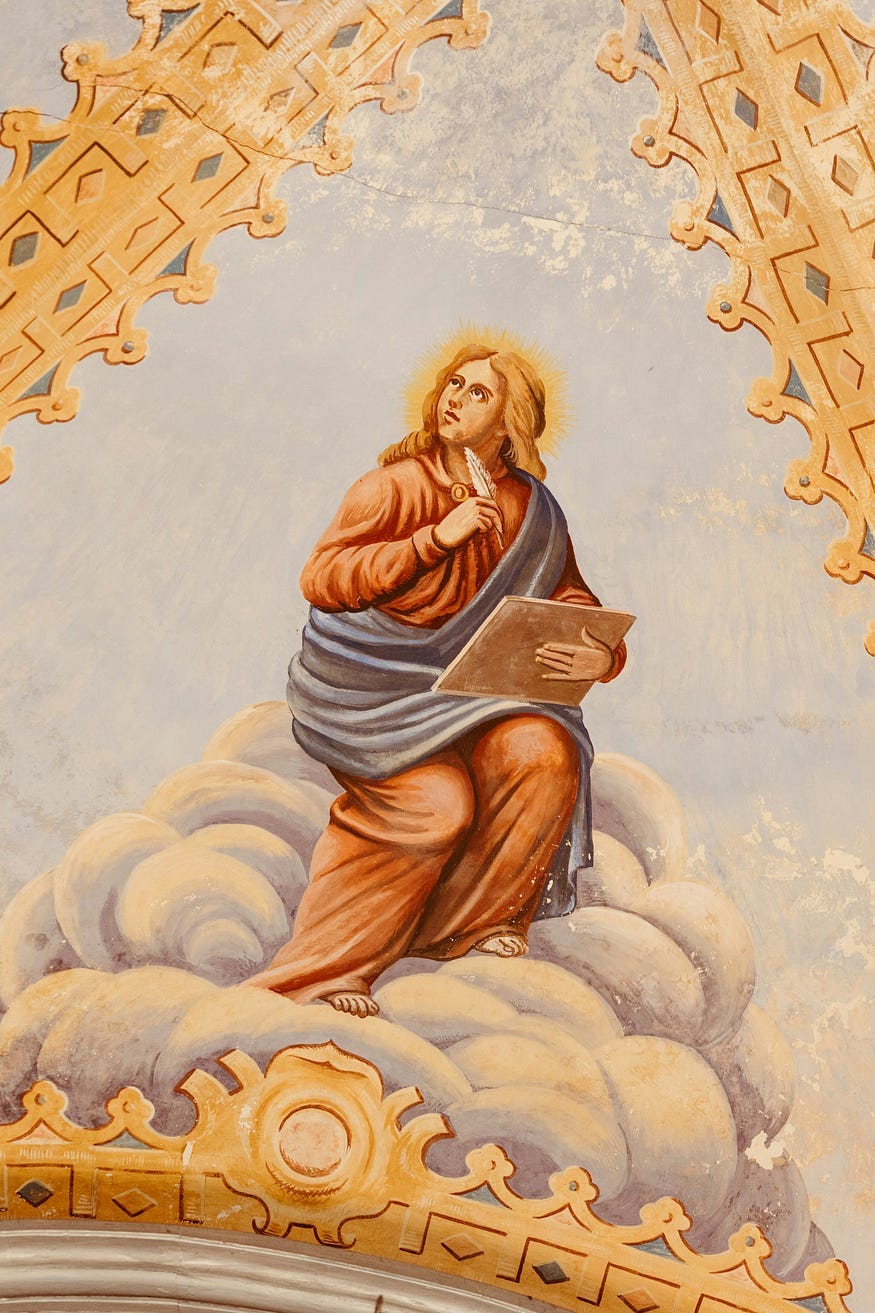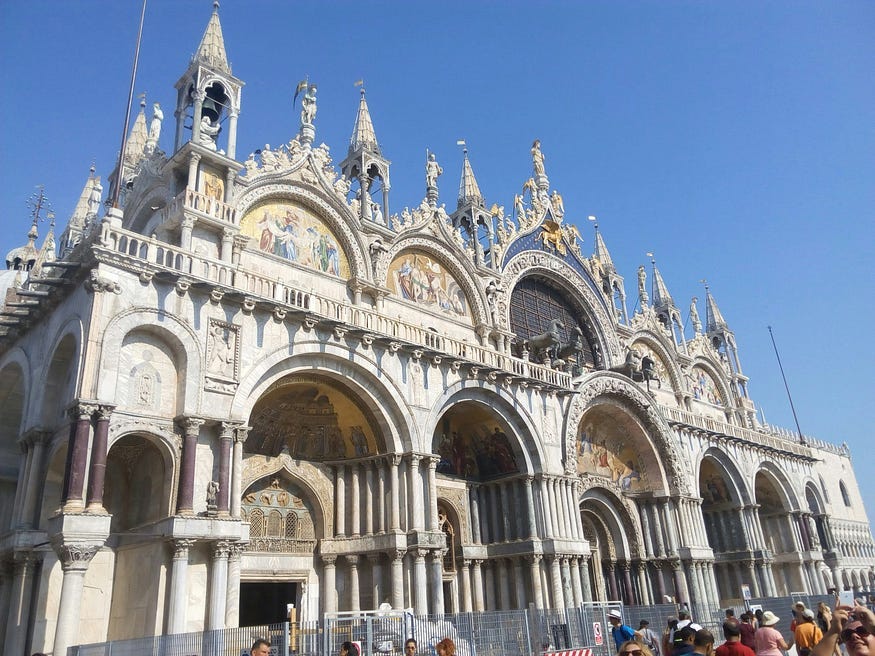Faith, Theft, & Flying Lions: The Strange Afterlife of Saint Mark
The Gospel That Ends in Silence
I hadn’t really set out to do a series of articles about Christian saints and sages but, hey, here we are.
People seem to like them and, y’know, being honest, I really enjoy learning about these lads and lasses.
Saint Mark’s feast day was on Friday, 25th, and he’s got quite the story…

The multifaceted legacy of Saint Mark
The pigeons are still asleep, which is saying something, given their usual caffeine-like addled frenzy. Piazza San Marco lies draped in that weird Venetian light, the kind that makes you question if you’ve woken up inside a painting or a hangover.
The basilica looms like a Byzantine fever dream, domes and arches dripping gold like a holy hallucination.
Somewhere underneath all that splendour, beneath the marble and the myths and the Starbucks queue forming just beyond the square, lies a corpse.
Well, not quite a corpse. A relic. The remains of a man who probably never imagined he’d become a geopolitical mascot, let alone the poster boy for an entire city-state.
His name was Mark. Saint Mark, if you’re into titles. Evangelist. Ghostwriter for Saint Peter. Alleged founder of the Coptic Church. Alleged owner of a lion with wings. Allegedly stolen in a barrel of pork fat by Venetian merchants who, to put it politely, didn’t believe in customs declarations.
And yet here he is. Or at least what’s left of him. A man who penned the most fast-paced, action-packed Gospel, barebones, no birth stories, miracles on speed, and who died somewhere in Alexandria, possibly being dragged through the streets by people who didn’t care for his views on resurrection.
From that brutal, dusty ending, we get Venice. The floating republic, the lion with wings, and the oddity of a dead Jewish writer becoming the divine co-pilot for a naval empire.
This isn’t a story about faith. Not really. It’s a story about appropriation, adaptation, and resurrection by myth.
Saint Mark, the original content creator, got turned into a brand. A man who wrote for Gentiles ended up being sold to tourists.
And yet, for all that mess, he still matters.
Let me show you why.

From biblical scribe to Venetian icon: decoding his dual identity
Before Venice got its hands on him, Mark was already a slippery figure. The Gospel of Mark, widely believed to be the first written, is a literary sprint.
There’s no nativity, no wise men, no pastoral poetry. Just Jesus hitting the ground running, healing the sick, flinging demons into pigs.
Some scholars think Mark was writing for an audience under pressure, persecuted Gentiles trying to make sense of a Messiah who didn’t save himself, let alone them. He offers miracles, yes, but also mystery.
In Mark’s world, Jesus is always telling people to keep schtum about the healings. It’s the Gospel of messianic secrecy.
Then Alexandria claims him. The Coptic tradition holds that Mark founded their church, wrote their liturgy, and died a gruesome martyr’s death at the hands of angry pagans. This Mark is different, not the quiet scribe, but the bold evangelist, planting the seeds of an Egyptian Christianity that still thrives today.
Centuries later, Venetian merchants show up and do what they do best: steal things.
They smuggle Mark’s relics out of Alexandria in 828 CE, disguising them under pork to evade Muslim customs officers. It’s a theft, a joke, and a miracle all rolled into one. They build a basilica, craft a mythology, and slap a lion on their flag. Suddenly, Mark isn’t just a saint, he’s state property.

The lion of Venice: how a saint shaped a city’s soul
That winged lion? It’s on everything. Flags, manhole covers, cappuccino cups. It snarls and soars, always clutching a book that reads Pax tibi Marce, evangelista meus (“Peace be with you, Mark, my evangelist”).
It’s meant to represent divine authority, but in Venice it came to mean more: independence, maritime power, and a smug sort of divine endorsement.
Compare that with Caravaggio’s Saint Jerome, brooding over his books, and you see the contrast. Jerome is the tortured intellectual.
Mark? Mark became a symbol of dominance. His Gospel tells stories of calming storms, exorcising demons, walking on water, and the Venetians, surrounded by sea and threats, latched onto that.
Mark was their spiritual sailor. Their miracle-worker on call.
Even the art tells the tale. The mosaics inside the Basilica of San Marco gleam like Byzantine fever dreams, all gold leaf and glittering halos. This isn’t the world of dusty Galilee. It’s divine branding.

Beyond the basilica: Saint Mark’s surprising influence on global culture
You’d think he’d stop at Venice. But no. Mark hits the spice routes.
Venetian traders spread the lion symbol like a proto-corporate logo, plastering it across Mediterranean ports. The lion shows up in obscure coats of arms, in stained glass windows in far-off French cathedrals, even in pop culture.
Ever notice the religious symbolism in North by Northwest? Mark gets a wink there, too, light, deception, and mistaken identity. It’s all very Gospel of Mark.
There’s even a culinary echo. Venetian traders, devout in ritual and ruthless in commerce, brought back more than just goods. They brought back more than goods. They brought back rituals.
Saint Mark’s Gospel, steeped in mystery and power, seeped into festival foods, symbolic dishes like risi e bisi, and the spices that turned Venetian kitchens into altars of empire.

Modern lessons from an ancient saint: relevance in a secular age
So, what do we do with Mark now? Is he just tourist bait and religious ephemera?
Or is there something deeper?
Mark’s Gospel is restless. It doesn’t explain everything. It leaves you dangling. The ending, at least in the earliest manuscripts, cuts off with the women fleeing from the empty tomb in fear and silence. No angels with trumpets. No Jesus floating into heaven. Just shock. Just questions.
I reckon that’s probably the point.
Mark understood the power of mystery. In an age where everyone was shouting, he whispered. He left space for ambiguity. For the unspoken. That kind of narrative restraint feels oddly modern. Or postmodern.
In a world drowning in content, perhaps Mark’s greatest gift is what he didn’t say.
And maybe that’s a lesson. For writers. For believers. For anyone trying to make peace with uncertainty.

Why Saint Mark still matters today
So here we are.
Back in the square. The sun is up now. The pigeons are flapping, the tour guides are rehearsing, and the basilica doors have creaked open. Saint Mark is still in there, under marble, behind glass, wrapped in myth.
He’s a saint. He’s a story. He’s a symbol. And he’s still shaping the world in quiet, peculiar ways.
He didn’t write to dazzle. He wrote in haste. In fragments. In hope. His gospel leaves us hanging: there’s no ascension, no closure, just women legging it and a stone rolled back.
And that’s why he still matters.
Because there are no easy endings. There will always be more questions than answers.
I’m Paddy Murphy — a counselor, teacher, and writer with over twenty years of experience helping people face the world without losing their soul. If this piece stirred something in you — if you’re tired of being told to switch off your feelings in order to keep up — I can help you reconnect with what matters. Not as a guru. Not as a brand. Just as someone who believes empathy is still worth fighting for.
If you want to talk things through, I offer a free 30-minute discovery call.
If you want more of this kind of writing — psychology, mental health, technology, philosophy, and the occasional digital heresy — you can sign up for my newsletter.
You can also support the work directly via PayPal. My different social media channels are here.



